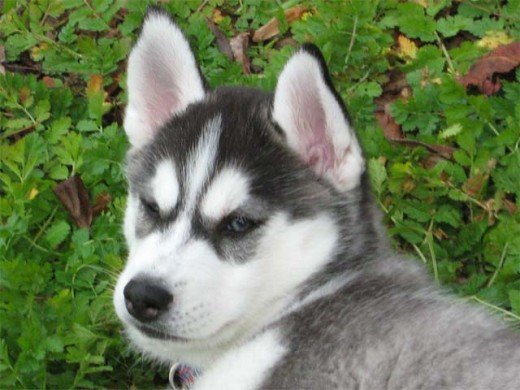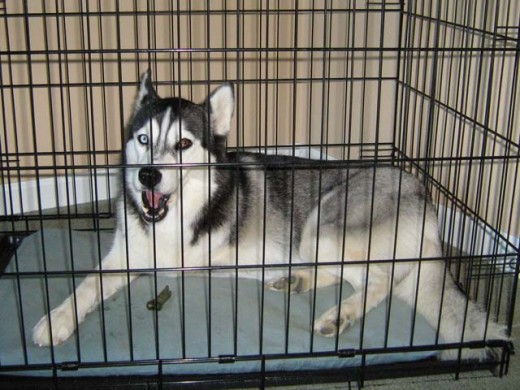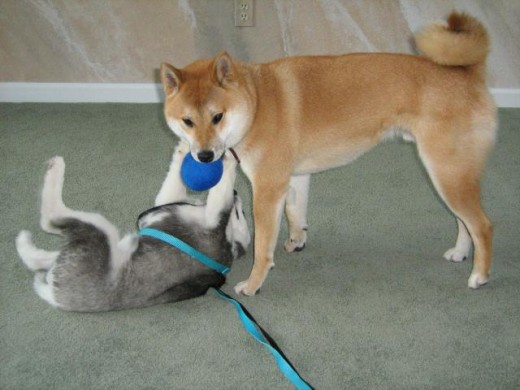Things to ask from our breeder –
- A blanket with smells from our puppy’s litter-mates and mother.
- Some of our puppy’s current food, so that we can slowly transition him over to his new diet.
- A favorite toy, so that he will have something familiar to play with, while he is getting used to his new surroundings.

1. New Puppy Supplies – Crate

Crating is important for a variety of dog issues, including puppy potty training and destructive chewing.
I get a crate that is large enough to accommodate my dog when he is full-grown. Initially, I put in a divider or a box, to make the crate smaller. Dogs do not like soiling in their sleeping area, therefore, by making the crate smaller, we discourage puppy from soiling inside it.
Put the smelly blanket and toy we got from our breeder, inside the crate. Puppy will feel safer and more relaxed, amid the smells of his litter-mates. Just make sure that the toy is chew-safe, and our puppy is unable to break-off or swallow little pieces of toy, which may be a choking hazard.
Some people think that crating is cruel for the dog.
Crating is only cruel if we leave puppy in there for too long, and he is forced to soil his sleeping area. When properly introduced, a crate can become a safe den for our dog; a place where he goes to sleep, eat, and get some peace and quiet.
The general guideline for maximum crate time is 1 crate-hour per month of age.
For example, an 8-week-old puppy can be crated for a maximum of 2 hours during the day. It is usually best to crate for less time than that, especially if we are not home, so that there is a healthy margin for error. Here are more detailed crate times taken from the ASPCA.
Here is what the Humane Society of the United States and the American Dog Trainer’s Network have to say about crate training.

2. New Puppy Supplies – Food and Treats
Research our puppy’s current dog food.
- Make sure it has a named meat as its primary ingredient. For example,
- Avoid food with artificial coloring, preservatives (e.g. BHA, BHT), or that contain too much filler material (e.g. corn hull).
- Avoid any food with wheat or corn gluten. Here’s why.
- Apply the same food ingredient rules to dog treats. Only get treats that do not contain unnecessary sugar, salt, or other additives. Split treats up into very small pieces so that we may reward puppy often, without overfeeding him.
Chicken > Chicken meal > Poultry meal > Poultry by-products

If his current food does not meet these requirements, then find a higher quality kibble and slowly transition him over to the new food. Some good kibble brands include Innova, Orijen, Nature’s Variety Instinct, Wellness, and Blue Buffalo.
Start with 1/4 portion of the new kibble, and 3/4 portion of the old kibble. Do this for 3-4 days, and observe puppy’s stool and behavior. If everything is well, then do 1/2 new, and 1/2 old kibble, and so on.
Gradually switching over to the new kibble, will ensure the least amount of digestive issues with our puppy.
If we have a large breed puppy, it is important NOT to feed him food that is too high in protein. It is generally safest to use puppy food until he is almost fully grown (usually about 1 year). It may be longer for larger breeds, and shorter for smaller breeds.
I called up the food company and consulted with my vet, before switching my first dog over to an adult, high-protein kibble.
Here is more on different dog diets and dog treats.

3. New Puppy Supplies – Lots of Interactive Toys and Chew Toys!

Most puppies are high energy, and love to chew.
Get our puppy some good chew toys, and make sure to supervise and teach him, which items are good to chew on, and which are not puppy safe. Every time puppy chews on something unacceptable, no-mark him (Ack-ack) and redirect him onto a sanctioned toy. When he redirects onto the toy, make sure to reward him by playing with him.
In this way, puppy learns that some toys are a lot more fun and rewarding than others, and he will quickly abandon the uninteresting, non-sanctioned items.
Kongs are great chew toys for my dogs. We can even put food into Kongs, which will motivate puppy to play with them, and exercise his mind. I put wet dog food into Bubble Kongs, and then freeze them. These are fun for dogs, and great for teething puppies.

I am a great fan of interactive food toys.
Wild animals spend most of their time working for their food. Domestic dogs who get food presented to them in a silver bowl, often get hyper, because they lack the physical and mental exercise of working for their dinner.
A great way to keep an energetic puppy occupied, is by making him work for his food, either through obedience training exercises or through interactive food toys. Be creative and challenge puppy with a variety of food puzzles and commands, but make sure to always set him up for success. If we make ‘work‘ fun and rewarding, it will help build puppy’s confidence and keep him coming back for more.
Note – some chew toys can be dangerous to dogs.
Chew toys that are overly hard and have no give (e.g. processed white bones, processed deer antler, hooves) may crack our dog’s teeth. My Shiba Inu cracked one of his pre-molars while chewing on a deer antler from AntlerZ.
Chew toys such as rawhide, may become a choking hazard. Dogs can tear off large chunks of the material at once, and when swallowed, the material may obstruct their throat or intestines. Rawhide is also very water absorbent. They may expand while in the dog’s intestines, and cause further digestive distress.
Always supervise when we give puppy soft toys to play with, or to fetch. Soft toys frequently have plastic parts that may be chewed off, and swallowed. Many squeaker toys contain plastic squeakers that can also be swallowed. These various toy parts, may become a choking hazard and cause digestive issues.
Here are a list of interactive food toys that have worked well for my dogs.

4. New Puppy Supplies – Grooming
Like walking, grooming is something we will have to do almost everyday with our dog, for the rest of his life. Therefore, it is important to make grooming into a fun and rewarding experience.
Some useful grooming supplies –
- Soft brush. Depending on breed, we may later want to switch over to the Furminator.
- Nail clipper and styptic powder. I prefer using a nail grinder (Dremel Minimmite) on my Shiba Inu because he is very sensitive to clipping.
- Small toothbrush and dog toothpaste.
- Dog wipes or shampoo in case puppy gets into something smelly.
Try to be very patient while grooming puppy, and do not rush the process. Many dogs become fearful of grooming because they are forced to endure it, rather than taught to enjoy it. Instead of using physical force, go slowly and reward puppy for working with us on a combined task.
Here are some tips on how to clean puppy’s teeth from home, and make it into a fun joint activity.
Note – Do not shampoo puppy too often. Brushing is the best way to remove most surface dirt. Shampooing too often, for example less than once per month, may cause our dog’s skin to dry out and his coat to become unhealthy.

5. New Puppy Supplies – Puppy Activities
Two key activities puppy will be engaged in initially, include potty training and leash training.
Some useful potty training supplies –
- Enzymatic pet cleaner for potty accidents.
- Puppy pads for situations where puppy is alone, and may not have outside access.
Other useful puppy supplies –
- Stainless steel food and water bowls. Some ceramic bowls may contain lead in their glaze. Plastic water bowls may be chewed, can be easily knocked over during play, and provides a more conducive environment for bacterial growth.
- Collar and leash. Get a 6 foot regular leash for walking. Retractable leashes do not give us enough control, during the training process. They are most appropriate for dogs that are already leash trained.

I use a 6 foot leather leash for walking my dog. Leather leashes are very durable, and comfortable on the hands.
I also use the Premier Martingale collar during walks. For smaller dogs, consider using a harness instead of a collar, so as not to accidentally hurt their neck.
I size the Martingale collar so that at its tightest, it is the size of a regular flat collar. I like the Premier collar because it is thick, sturdy, and not susceptible to breaking or slipping-out. However, as with other training collars, they are only appropriate under supervision. They should be removed after the walk, or whenever our dog is off-leash.
Note – Do not perform leash jerks or leash corrections on puppies. Even traditional trainers do not recommend using leash corrections on dogs, until they are at least 16 weeks of age. In general, any physical corrective methods are inappropriate for young puppies, including alpha rolls.
Only use reward training techniques on puppies. If we want to switch to aversive training methods, wait until the dog is older, or we will risk hurting him mentally and physically.

6. New Puppy Supplies – Dog Bed
Many people get designer soft beds for their dogs. However, while most people do prefer soft beds, this is not necessarily the case for dogs.
The bed that has worked very well for both my dogs, are elevated outdoor beds. I have two outside, and one inside.
During cold weather, the dogs will curl up on the carpeted landing, or in front of the fireplace. During warm weather, they like sleeping on the elevated bed, or on the tiled floor areas.
Soft beds were just looked upon as chew toys, and not as beds 🙂
During the puppy stage, there may also be potty mistakes on the bed. It is extremely difficult to get all the smell out of soft bedding, which can further encourage more mistakes. Therefore, it may be best to hold off on the soft beds, until puppy is fully house trained.
I also have a cool bed (water bed) for my Siberian Husky, which I put in her crate. If we have a thick-coated or double coated dog breed, the cool bed can help to cool things down during hot days and nights.
Make sure to get a bed with removable, washable covers. The beds frequently get a lot of fur and dirt on them, and it is a lot easier to just remove and wash the covers.

7. New Puppy Supplies – Conclusion
Most of all, make sure we have a good supply of humor and patience.
A puppy is a crazy ball of energy, and can be a highly destructive force.
Humor and patience will be needed to redirect that energy into positive areas, and away from the Dark Side.

Hi ShibaShake,
My boyfriend and I are getting a shiba inu puppy soon. I started doing my own research awhile ago (this is my first pet and I want to be as prepared as possible). After finding your site, I wanted to thank you for sharing all your experiences and knowledge on the Shiba and Husky breeds! I am still exploring all the articles, but at this point I am focused on getting the basics for a shiba puppy. You mentioned using a soft grooming brush — do you have any specific recommendations on this? When shopping, there are so many options that it’s a bit overwhelming. Slicker? Furminator? Rake?
Any advice is much appreciated 🙂
Hi! I am also in the process of getting a Shiba Inu puppy and I wanted to know where will you be getting yours from?
I live in NYC and I haven’t had any luck with local breeders. Are you getting yours from a private breeder or store?
I would stay away from pet stores, online stores, and backyard breeders, especially for a breed like the Shiba Inu. I got my Shiba through an online store type place, and his breeder turned out to be more of a backyard breeder and less of a reputable breeder even though she had papers etc. She didn’t ask me any questions about my home conditions, and all she cared about was getting her money. Sephy had temperament issues right from the start, and is extremely sensitive to handling. When we took him to the vet for his very first checkup, the next day after getting him, the vet recommended that we return him. After much work, training, and management, Sephy is much better today, but he is still easily stressed and still sensitive about handling, especially by strangers.
I got both my Huskies from a registered AKC breeder who asked me a lot of questions about my home conditions. She also did a home check before giving me one of her precious puppies, and the difference in her puppies is tremendous. They already had good socialization when young, have much calmer dispositions, are good about handling, and are much easier to train.
Here are some of my experiences on what to look for when getting a puppy. It is about my Husky puppy, but the same will apply for a Shiba puppy.
In my experience, it really makes a huge difference. Also, supporting puppy stores and online puppy stores, will contribute to the puppy mills behind them.
There is also a great Shiba rescue in NYC, with people who know a lot about Shibas. They can probably put you in touch with good reputable breeders.
http://nycshibarescue.org/
I love your website! It’s so cool!